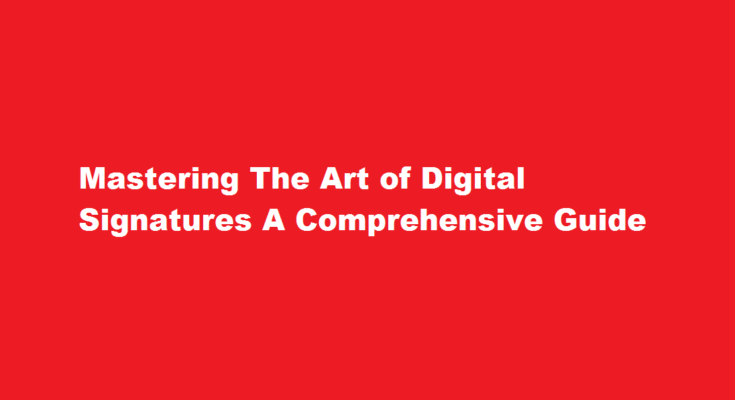Introduction
In the digital age, the importance of secure and reliable electronic transactions cannot be overstated. Digital signatures play a crucial role in ensuring the authenticity, integrity, and non-repudiation of electronic documents, contracts, and messages. By adopting digital signatures, individuals and organizations can enhance their data security, streamline workflows, and build trust with their customers. In this article, we will delve into the world of digital signatures, exploring what they are, how they work, and the steps to create and verify them.
Understanding Digital Signatures
Digital signatures are electronic counterparts of traditional handwritten signatures. They are cryptographic mechanisms that help verify the authenticity of a digital message or document and ensure that it remains unchanged during transmission. When you digitally sign a document, you create a unique cryptographic signature that is securely linked to the content.
Key Components of Digital Signatures
To comprehend digital signatures better, let’s understand their fundamental components
- Private Key Every individual or organization utilizing digital signatures possesses a private key. It is a closely guarded secret that should never be shared with anyone else. The private key is used to create the digital signature.
- Public Key This key is derived from the private key and can be openly shared with others. It is used to verify the digital signature.
- Certificate A digital certificate is issued by a trusted third party, known as a Certificate Authority (CA). It contains the public key and identifies the owner of the private key.
How Digital Signatures Work
The process of creating and verifying digital signatures involves several steps
Hashing
Before signing a document, a cryptographic hash function is applied to the content. This produces a fixed-length sequence of characters, often referred to as a hash value or message digest. Even the slightest modification to the original content will result in a vastly different hash value.
Signing
The private key is then used to encrypt the hash value, generating the digital signature. This signature is unique to both the content and the private key used to create it.
Verification
To verify the digital signature, the recipient or verifier uses the signer’s public key to decrypt the signature, obtaining the original hash value. Next, they independently compute the hash value of the received content. If the two hash values match, the signature is valid, and the document remains unchanged.
Creating a Digital Signature
Creating a digital signature requires the following steps
- Generate Key Pair
Begin by generating a secure key pair – a private key and its corresponding public key. This can be done using various cryptographic software or hardware tools.
- Obtain a Digital Certificate
To build trust in your digital signature, obtain a digital certificate from a recognized Certificate Authority. The CA will validate your identity and associate your public key with your name or organization.
- Sign the Document
Using your private key, sign the electronic document or message. This process will generate the digital signature unique to that specific document.
- Distribute the Document
Share the digitally signed document along with the digital certificate to the intended recipients.
Verifying a Digital Signature
Verifying a digital signature involves these steps
- Obtain the Public Key
Ensure you have the signer’s public key. This is typically included in the digital certificate accompanying the document.
- Extract the Signature
Separate the digital signature from the document.
- Decrypt the Signature
Use the public key to decrypt the digital signature, revealing the hash value.
- Recompute the Hash
Independently compute the hash value of the received document.
- Compare Hashes
If the decrypted hash value matches the re-computed hash value, the signature is valid, and the document is authentic and unchanged.
Advantages of Digital Signatures
Adopting digital signatures offers numerous benefits, including
- Enhanced Security Digital signatures use strong encryption algorithms, making them tamper-proof and secure against unauthorized alterations.
- Cost and Time Savings Digital signatures eliminate the need for physical document transportation and manual authentication, reducing administrative costs and streamlining workflows.
- Non-Repudiation A valid digital signature provides evidence that the signer cannot deny their involvement, promoting accountability.
- Global Acceptance Digital signatures are legally recognized in many countries, facilitating cross-border transactions.
Frequently Asked Questions
How does a digital signature work step by step?
When a signer electronically signs a document, the signature is created using the signer’s private key, which is always securely kept by the signer. The mathematical algorithm acts like a cipher, creating data matching the signed document, called a hash, and encrypting that data.
How are digital signatures verified?
Verifying a signature will tell you if the signed data has changed or not. When a digital signature is verified, the signature is decrypted using the public key to produce the original hash value. The data that was signed is hashed. If the two hash values match, then the signature has been verified.
Conclusion
As the digital world continues to expand, the need for secure and reliable electronic transactions becomes paramount. Digital signatures offer a robust solution to establish trust, authenticity, and data integrity in the realm of electronic documents and communications. By understanding the components and workings of digital signatures and following best practices, individuals and organizations can harness the power of these cryptographic tools to safeguard their digital interactions effectively. Embracing digital signatures not only bolsters data security but also paves the way for efficient, paperless, and legally binding transactions in the digital era.
Read Also : Mastering Squats A Comprehensive Guide to Proper Form and Variations



